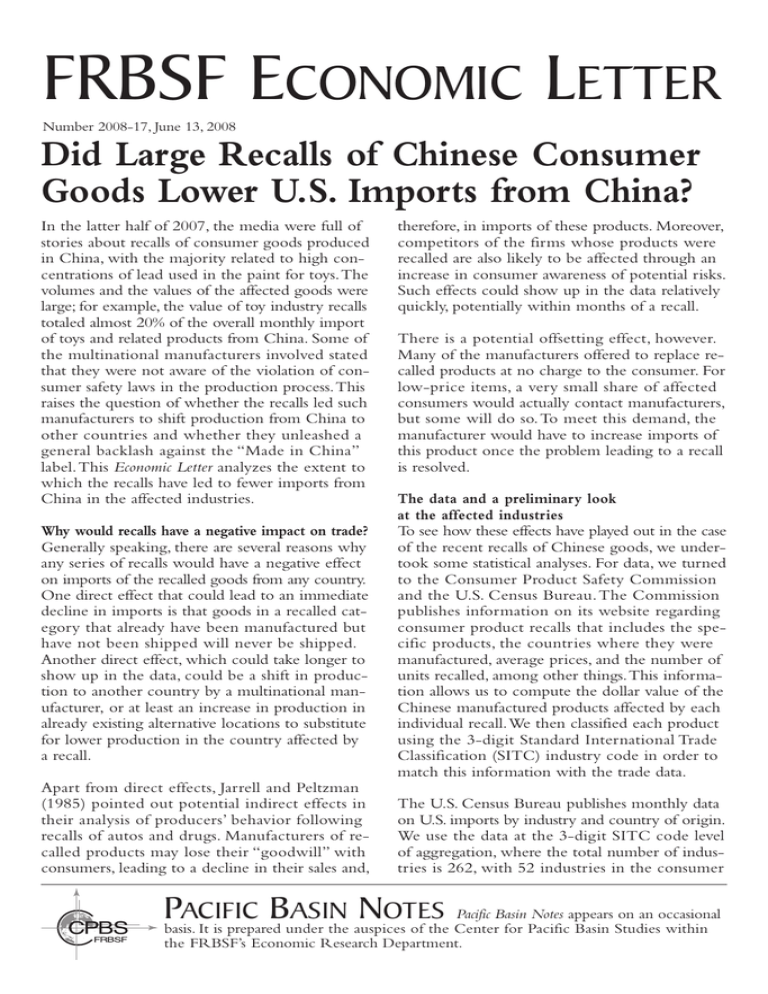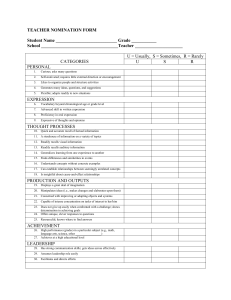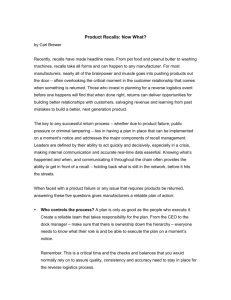FRBSF E L CONOMIC ETTER
advertisement

FRBSF ECONOMIC LETTER Number 2008-17, June 13, 2008 Did Large Recalls of Chinese Consumer Goods Lower U.S. Imports from China? In the latter half of 2007, the media were full of stories about recalls of consumer goods produced in China, with the majority related to high concentrations of lead used in the paint for toys.The volumes and the values of the affected goods were large; for example, the value of toy industry recalls totaled almost 20% of the overall monthly import of toys and related products from China. Some of the multinational manufacturers involved stated that they were not aware of the violation of consumer safety laws in the production process.This raises the question of whether the recalls led such manufacturers to shift production from China to other countries and whether they unleashed a general backlash against the “Made in China” label.This Economic Letter analyzes the extent to which the recalls have led to fewer imports from China in the affected industries. Why would recalls have a negative impact on trade? Generally speaking, there are several reasons why any series of recalls would have a negative effect on imports of the recalled goods from any country. One direct effect that could lead to an immediate decline in imports is that goods in a recalled category that already have been manufactured but have not been shipped will never be shipped. Another direct effect, which could take longer to show up in the data, could be a shift in production to another country by a multinational manufacturer, or at least an increase in production in already existing alternative locations to substitute for lower production in the country affected by a recall. Apart from direct effects, Jarrell and Peltzman (1985) pointed out potential indirect effects in their analysis of producers’ behavior following recalls of autos and drugs. Manufacturers of recalled products may lose their “goodwill” with consumers, leading to a decline in their sales and, therefore, in imports of these products. Moreover, competitors of the firms whose products were recalled are also likely to be affected through an increase in consumer awareness of potential risks. Such effects could show up in the data relatively quickly, potentially within months of a recall. There is a potential offsetting effect, however. Many of the manufacturers offered to replace recalled products at no charge to the consumer. For low-price items, a very small share of affected consumers would actually contact manufacturers, but some will do so. To meet this demand, the manufacturer would have to increase imports of this product once the problem leading to a recall is resolved. The data and a preliminary look at the affected industries To see how these effects have played out in the case of the recent recalls of Chinese goods, we undertook some statistical analyses. For data, we turned to the Consumer Product Safety Commission and the U.S. Census Bureau. The Commission publishes information on its website regarding consumer product recalls that includes the specific products, the countries where they were manufactured, average prices, and the number of units recalled, among other things.This information allows us to compute the dollar value of the Chinese manufactured products affected by each individual recall.We then classified each product using the 3-digit Standard International Trade Classification (SITC) industry code in order to match this information with the trade data. The U.S. Census Bureau publishes monthly data on U.S. imports by industry and country of origin. We use the data at the 3-digit SITC code level of aggregation, where the total number of industries is 262, with 52 industries in the consumer PACIFIC BASIN NOTES Pacific Basin Notes appears on an occasional basis. It is prepared under the auspices of the Center for Pacific Basin Studies within the FRBSF’s Economic Research Department. FRBSF Economic Letter products category. In these industries, 189 product groups overall and 46 product groups in the consumer products category were consistently imported from China between 2000 and 2007. 2 Number 2008-17, June 13, 2008 Figure 1 Importance of recall industries and the value of recalls in these industries Based on these data, we limited our analysis to the 63 industries that accounted for 92% of all imports from China in 2007.Among these, 13 experienced recalls in the third quarter of 2007.Their share of total imports from China in 2006 is presented in Figure 1, along with the value of the recalls as a percentage of monthly imports from China in a given industry.We choose the 2006 share because the 2007 share might be affected by recalls.The 13 industries affected by recalls in the third quarter of 2007, when combined, represent almost 40% of total imports from China. As the figure shows, recalls in “toys, baby items” and in “furniture, bedding” were quite substantial, especially because the volume of imports in these industries is large. In absolute terms, recalls amounted to more than $2.5 billion in each of these industries, which represents about 10% of monthly toy industry imports from China and about 20% of monthly furniture industry imports from China.The other category substantially affected by recalls was household appliances; here, the recalls amounted to about $3 million, or 5% of monthly imports from China by this industry. Forecast results Our aim is to study the effect that the recalls of products manufactured in China had on U.S. imports from the affected industries in that country. In doing so, it is obviously not enough to look only at the dynamics of imports, because they may be affected by many other factors, such as seasonal fluctuations in demand and transportation costs.Therefore, to isolate the effect of recalls, we use monthly data between 2000 and the second quarter of 2007 on imports from each of the selected 63 industries to forecast what the imports in these industries would have been in the second half of 2007.Therefore, we forecast imports in each of the 63 selected industries in the second half of 2007 using lagged monthly imports in these industries as well as indicators of each month and of Chinese New Year in order to control for seasonality. Unpredictable changes occur all the time in the economy, and therefore our forecast, of course, does not correspond to actual imports, either for industries affected by the recalls or for industries Bars: share of total imports (%). Numbers in bold indicate the recall value as a share of monthly imports in the industry (%). not affected. In fact, we find that, on average, we underpredict the volume of imports in the second half of 2007 by 5.1%.We have no reason to believe, however, that the direction of the error in our forecast would be different in industries affected by recalls as opposed to other industries for any other reason than the recalls themselves. Figure 2 plots the actual and forecasted share of total imports from China for both recall and nonrecall industries.We can see that imports in nonrecall industries were on average higher than our forecasts, while imports in industries affected by recalls were on average lower.This indicates that recalls were likely responsible for slower growth in the affected industries’ imports than we would have observed otherwise. In order to see which industries are driving our results, we compute the percentage difference between actual imports and their forecasted values in the second half of 2007 for each recall industry. The results are presented in Figure 3, where a positive number means that actual volume of imports was larger than our forecast, and a negative number means that the actual volume of imports was smaller than our forecast.As mentioned above, the average difference between the actual imports and the forecast is 5.1%, which is represented by the thick line on the graph. FRBSF Economic Letter Figure 2 Differences between the data and the forecasts for recall and non-recall industries, 2007 3 Number 2008-17, June 13, 2008 Figure 3 Difference between actual and forecasted imports by recall industry A. Non-recall industries B. Recall industries Bars: Cumulative forecast error. such as production relocation, could take a longer time.We can infer that, on average, and with the notable exception of the toy industry, recalls of consumer products manufactured in China did have an adverse effect on U.S. imports from China. These effects, however, are not particularly large, given the overall growth of imports from China, especially in the affected industries. It remains to be seen whether adverse reputation effects of product recalls on the “Made in China” label will eventually produce a substantial dent in U.S. imports from China. We can see that, in most recall industries, actual imports either fell short of our forecasts (negative values) or did not exceed our forecasts by as much as the average 5.1%. Imports in the toy and paper product industries, however, were larger than our forecasts, indicating either that recalls did not have much of an impact or that the need to replace recalled products led to a temporary boost in imports. Conclusion Given that we are limited to using data for only the three- to five-month period following the recalls, it is difficult to draw a firm conclusion from the analysis, because some effects of recalls, Christopher Candelaria Research Associate Galina Hale Economist References Consumer Product Safety Commission: Recalls and Product Safety News. http://www.cpsc.gov/ cpscpub/prerel/prerel.html Jarrell, Gregg, and Sam Peltzman. 1985. “The Impact of Product Recalls on the Wealth of Sellers.” Journal of Political Economy 93(3), pp. 512–536. ECONOMIC RESEARCH FEDERAL RESERVE BANK OF SAN FRANCISCO PRESORTED STANDARD MAIL U.S. POSTAGE PAID PERMIT NO. 752 San Francisco, Calif. P.O. Box 7702 San Francisco, CA 94120 Address Service Requested Printed on recycled paper with soybean inks Index to Recent Issues of FRBSF Economic Letter DATE 10/26 11/2 11/23 11/30 12/7 12/14 1/18 1/25 2/1 2/8 2/15 2/22 2/29 3/7 3/14 3/21 4/11 4/18 5/9 6/6 NUMBER 07-32 07-33 07-34 07-35 07-36-37 07-38 08-01 08-02 08-03 08-04-05 08-06 08-07 08-08 08-09 08-10 08-11 08-12 08-13-14 08-15 08-16 TITLE Asset Price Bubbles Labor Force Participation and the Prospects for U.S. Growth Financial Globalization and Monetary Policy Fixing the New Keynesian Phillips Curve The U.S. Economy and Monetary Policy Sovereign Wealth Funds: Stumbling Blocks or Stepping Stones...? Publishing FOMC Economic Forecasts Publishing Central Bank Interest Rate Forecasts 2007 Annual Pacific Basin Conference: Summary Prospects for the Economy in 2008 Recent Trends in Economic Volatility: Conference Summary Economic Conditions in Singapore and Vietnam: A Monetary... The Economics of Private Equity Investments: Symposium Summary Assessing Employment Growth in 2007 The Corporate Bond Credit Spread Puzzle Falling House Prices and Rising Time on the Market Are Global Imbalances Due to Financial Underdevelopment...? The Financial Markets, Housing, and the Economy Small Business Lending and Bank Competition Retirement Savings and Decision Errors: Lessons from Behavioral... AUTHOR Lansing Daly/Regev Spiegel Dennis Yellen Aizenman/Glick Rudebusch Rudebusch Glick Yellen Notzon/Wilson Yellen Lopez Regev Christensen Krainer Valderrama Yellen Laderman Armour/Daly Opinions expressed in the Economic Letter do not necessarily reflect the views of the management of the Federal Reserve Bank of San Francisco or of the Board of Governors of the Federal Reserve System.This publication is edited by Judith Goff, with the assistance of Anita Todd. Permission to reprint portions of articles or whole articles must be obtained in writing. Permission to photocopy is unrestricted. Please send editorial comments and requests for subscriptions, back copies, address changes, and reprint permission to: Public Information Department, Federal Reserve Bank of San Francisco, P.O. Box 7702, San Francisco, CA 94120, phone (415) 974-2163, fax (415) 974-3341, e-mail sf.pubs@sf.frb.org. The Economic Letter and other publications and information are available on our website, http://www.frbsf.org.




